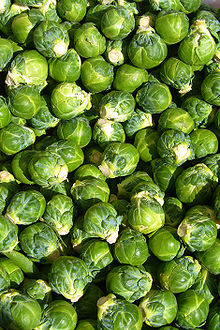Brussels sprout
| Brussels | |
|---|---|

Brussels sprouts (cultivar unknown)
|
|
| Species | Brassica oleracea |
| Cultivar group | Gemmifera Group |
| Origin |
Low Countries (year unknown) |
| Nutritional value per 100 g (3.5 oz) | |
|---|---|
| Energy | 179 kJ (43 kcal) |
|
8.95 g
|
|
| Sugars | 2.2 g |
| Dietary fibre | 3.8 g |
|
0.3 g
|
|
|
3.48 g
|
|
| Vitamins | |
| Vitamin A equiv. |
(5%)
38 μg
(4%)
450 μg1590 μg
|
| Thiamine (B1) |
(12%)
0.139 mg |
| Riboflavin (B2) |
(8%)
0.09 mg |
| Niacin (B3) |
(5%)
0.745 mg |
| Pantothenic acid (B5) |
(6%)
0.309 mg |
| Vitamin B6 |
(17%)
0.219 mg |
| Folate (B9) |
(15%)
61 μg |
| Choline |
(4%)
19.1 mg |
| Vitamin C |
(102%)
85 mg |
| Vitamin E |
(6%)
0.88 mg |
| Vitamin K |
(169%)
177 μg |
| Minerals | |
| Calcium |
(4%)
42 mg |
| Iron |
(11%)
1.4 mg |
| Magnesium |
(6%)
23 mg |
| Manganese |
(16%)
0.337 mg |
| Phosphorus |
(10%)
69 mg |
| Potassium |
(8%)
389 mg |
| Sodium |
(2%)
25 mg |
| Zinc |
(4%)
0.42 mg |
| Other constituents | |
| Water | 86 g |
|
approx. 5-10 sprouts per 100 g
Link to USDA Database entry |
|
|
|
| Percentages are roughly approximated using US recommendations for adults. Source: USDA Nutrient Database |
|
The Brussels sprout is a member of the Gemmifera Group of cabbages (Brassica oleracea), grown for its edible buds.
The leafy green vegetables are typically 2.5–4 cm (0.98–1.6 in) in diameter and look like miniature cabbages. The Brussels sprout has long been popular in Brussels, Belgium, and may have originated and gained its name there.
Although native to the Mediterranean region with other cabbage species, Brussels sprouts first appeared in northern Europe during the fifth century, later being cultivated in the thirteenth century near Brussels from which they derived their name.
Forerunners to modern Brussels sprouts were likely cultivated in Ancient Rome. Brussels sprouts as they are now known were grown possibly as early as the 13th century in what is now Belgium. The first written reference dates to 1587. During the 16th century, they enjoyed a popularity in the Southern Netherlands that eventually spread throughout the cooler parts of Northern Europe.
Brussels sprouts grow in temperature ranges of 7–24 °C (45–75 °F), with highest yields at 15–18 °C (59–64 °F). Fields are ready for harvest 90 to 180 days after planting. The edible sprouts grow like buds in helical patterns along the side of long, thick stalks of about 60 to 120 cm (24 to 47 in) in height, maturing over several weeks from the lower to the upper part of the stalk. Sprouts may be picked by hand into baskets, in which case several harvests are made of five to 15 sprouts at a time, or by cutting the entire stalk at once for processing, or by mechanical harvester, depending on variety. Each stalk can produce 1.1 to 1.4 kg (2.4 to 3.1 lb), although the commercial yield is about 900 g (2.0 lb) per stalk. Harvest season in temperate zones of the northern latitudes is September to March, making Brussels sprout a traditional winter stock vegetable. In the home garden, harvest can be delayed as quality does not suffer from freezing. Sprouts are considered to be sweetest after a frost.
Brussels sprouts are a cultivar group of the same species as cabbage, in the same family as collard greens, broccoli, kale, and kohlrabi; they are cruciferous (they belong to the Brassicaceae family; old name Cruciferae). Many cultivars are available, some being purple in colour, such as 'Ruby Crunch' or 'Red Bull'.
...
Wikipedia
